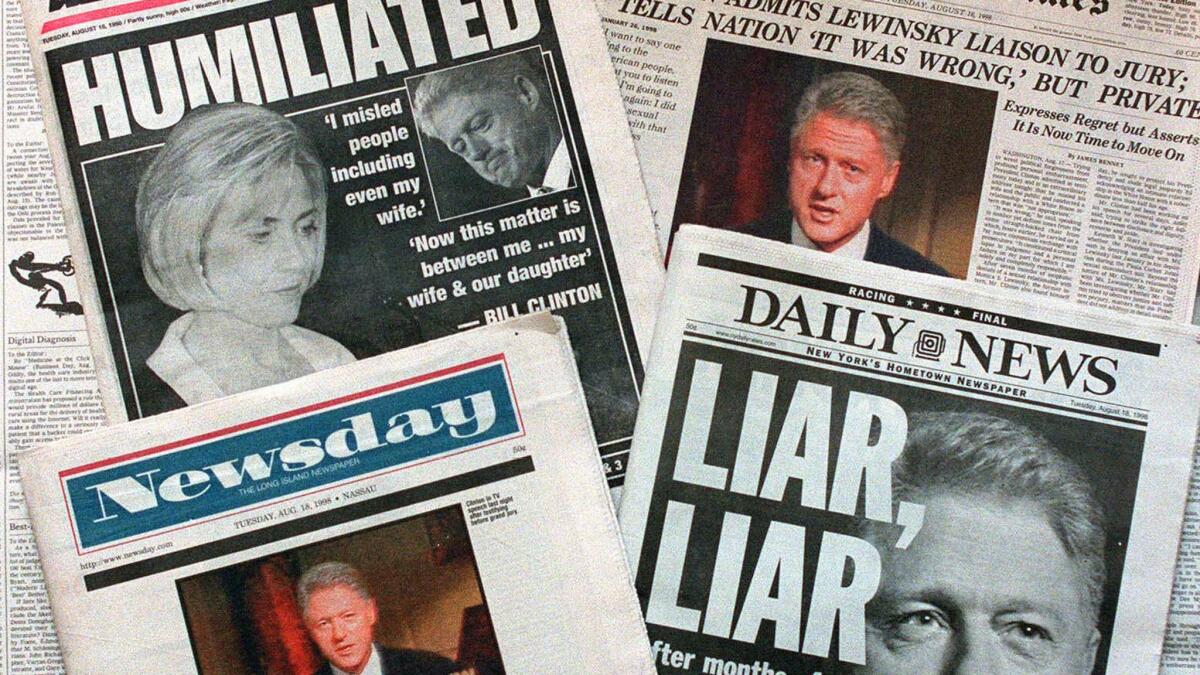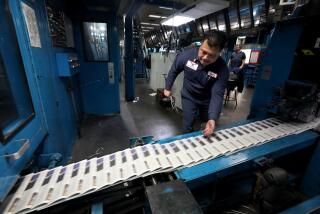Los Angeles Times’ parent company acquires New York Daily News

In a stunning and bold bet on the future of newspapers, Tronc, the parent company of the Los Angeles Times, has acquired the New York Daily News.
The deal for the tabloid, which includes the Daily News’ website and other assets, has been in the works for some months and was finalized Sunday. The deal carries a price tag of $1 and the assumption of operational and pension liabilities.
“We think this is a great deal for the paper and for us,” said Justin Dearborn, Tronc’s chief executive. “We expect it to benefit greatly from becoming part of the Tronc ecosystem.”
Tronc, formerly known as Tribune Publishing, has been actively engaged in high-profile merger talks with other newspapers since technology entrepreneur Michael Ferro became the company’s largest shareholder and chairman in February 2016, but the Daily News acquisition is the first to come to fruition.
In March 2016, Tronc was the top bidder for the bankrupt Orange County Register, but Justice Department antitrust concerns over the Register’s proximity to the Los Angeles Times thwarted the deal. And newspaper chain Gannett, publisher of USA Today and more than 100 other titles, abandoned a contentious and unsolicited six-month pursuit of Tronc in November.
Acquiring the Daily News comes less than a month after Tronc’s unsuccessful attempt to purchase the Chicago Sun-Times, which was acquired in early August by an investment group led by former Chicago Alderman Edwin Eisendrath and labor unions, among others.
Tronc operates newspapers in nine U.S. markets, including Chicago, Los Angeles, Baltimore and Orlando, Fla.
The New York Daily News had been owned since 1993 by billionaire Morton Zuckerman and his onetime business partner, Fred Drasner. The latter left the company in 2004. Two years ago, Zuckerman seriously explored selling the newspaper but eventually abandoned those plans.
Buying a newspaper is risky business these days, with traditional print advertising revenue declining in the face of digital competition. While small- and medium-market newspapers have been more insulated from the disruption, Tronc is going all-in on major market newspapers as a platform to grow its digital business.
“We have always been interested in the New York market,” Dearborn said. “The Sun-Times deal in no way changed our plans. This transaction came about through a mutual friend of both companies who initiated a conversation that led to this transaction.”
Added Tim Knight, Tronc president: “The Daily News has a great staff and also has 24 million unique visitors to its website. That really fits into our plans. This increases our digital audience by almost 40%. It also gives us what we feel will be a very efficient national platform and significant digital presence across the country.”
In essence, the Daily News deal brings a former Tribune sibling back into the Tronc newspaper fold.
The Daily News began its tabloid life in 1919, the result of a clash of wills and philosophies between Joseph Medill Patterson and his cousin Robert R. McCormick. They were the grandsons of Joseph Medill, who had founded the Chicago Tribune in 1847, and became co-publishers of that paper in 1910.
Together they created the “World’s Greatest Newspaper” slogan that adorned the paper’s front page, but the two differed on so many matters both business and political that on June 26, 1919, Patterson published the first issue in New York of what was then called the Illustrated Daily News. It struggled for a few months but soon proved a hit in that wildly competitive newspaper market, which at the time consisted of 11 daily newspapers in Manhattan, three in Brooklyn and dozens of weekly publications throughout the city.
Its circulation topped 100,000 within a year and was over 1 million by 1925. Its peak circulation was in 1947, when it sold 2.4 million copies daily and 4.7 million on Sunday. One reason was its comics, as Patterson played inspirational godfather to a generation of comic artists, helping to create and nourish in his paper’s pages such strips as “Gasoline Alley,” “Moon Mullins,” “Little Orphan Annie,” “Terry and the Pirates” and “Dick Tracy.”
The paper’s circulation currently stands at about 200,000 daily and 260,000 Sunday, placing it solidly among the top 10 U.S. newspapers, along with the Tribune and Los Angeles Times. But it has not been profitable for some years, though Tronc executives anticipate they will be able to meet all financial obligations through the Daily News’ cash flow.
Tronc sees cost efficiencies and opportunities for revenue growth, including Tronc’s scale, to operate the Daily News less expensively and attract more printing clients to the New Jersey plant acquired as part of the deal. Dearborn expects the Daily News to be operating in the black by next year.
For more than seven decades the paper carried and lived up to the slogan “New York’s Picture Newspaper.” From 1920 to 1991, with a camera as part of its logo, it was a feast of photographs, with solid reporting focused on the city.
With its later slogans — “New York’s Hometown Newspaper” and “The Eyes, the Ears, the Honest Voice of New York” — it was known for its street-savvy reporting and its snappy and to-the-point headlines. Arguably the most famous appeared on Oct. 30, 1975: “Ford to City: Drop Dead,” a reference to a speech in which then-President Gerald Ford said he would deny any federal assistance to spare New York City from declaring bankruptcy.
The Daily News’ staff was energetic and included the late legendary columnist Jimmy Breslin, a native New Yorker whose scrappy and brash personal style reflected that of the paper. He started there in 1976 and over the next dozen years was a daily must-read, winning the Pulitzer Prize for commentary in 1986, for “columns which consistently champion ordinary citizens.”
The paper has won nearly a dozen Pulitzer Prizes, including its first in 1937 for editorial cartooning (C.D. Batchelor) and, most recently, sharing the 2017 Pulitzer in public service with the nonprofit ProPublica for reporting on widespread abuse of eviction rules by the police.
The Tribune owned the paper until 1991, though the company attempted to sell it in the wake of a newspaper strike in 1982. In 1991, it was bought by British billionaire and media mogul Robert Maxwell. But after his death that same year, and the revelations of Maxwell’s shaky financial empire, the paper’s existing management held the publication together through bankruptcy before its 1993 Zuckerman-Drasner purchase for $36 million.
The paper “has been serving New York City and its surrounding areas with its award-winning journalism for almost a century,” Zuckerman said in a statement. “As the media landscape continues to evolve, combining with Tronc will enhance the [paper’s] product and allow it to continue providing quality news and information.”
The newspaper is housed in offices in lower Manhattan and is printed in a 425,000-square-foot facility near Liberty State Park in Jersey City, N.J. It opened in 1996 and in 2009 was upgraded with the $150-million installation of high-speed presses. The property offers spectacular views of lower Manhattan and the Statue of Liberty.
“That was certainly an added inducement to this transaction,” said Knight. As part of this transaction, Tronc will own the printing plant as well as a 49.9% interest in a joint venture with Zuckerman to own and be able to eventually develop the 25-acre parcel on which the printing facility sits, Knight said.
The Daily News’ editor in chief for the last year has been Arthur Browne, who began his career as a copy boy at the paper in 1973. Some months ago he announced his intention to retire but has agreed to stay through the end of the year and to take on the added duties of publisher. The newspaper employs some 800 people, with roughly 200 of them in the newsroom.
“We are not finished and are determined to continue to be active in the mergers and acquisitions market,” Dearborn said. “We are opportunistic and you will likely see more digitally focused acquisitions. This was just such a great opportunity. Good timing. Good chemistry.”
Kogan and Channick write for the Chicago Tribune.
More to Read
Inside the business of entertainment
The Wide Shot brings you news, analysis and insights on everything from streaming wars to production — and what it all means for the future.
You may occasionally receive promotional content from the Los Angeles Times.











